Skydiving Slang Phrases: What They Mean and How to Use Them

Here’s the scene: You’re a baby bird skydiver and you just want to know some cool (and quite necessary) skydiving slang to help you integrate into the DZ life! Don’t worry, we’ve all been there. We have you covered with the top skydiving phrases and terminology in this skydiving glossary to make your introduction to the jumping world a literal breeze. These skydiving slang meanings are likely to leave you with many an “Aha!” moment. Let’s get into it!
A | B | C | D | E | F | G | H | I | J | K | L | M | N | O | P | R | S | T | W | Z
A
AAD: An Automatic Activation Device (AAD) is a teeny tiny computer fastened in the container. It calculates a skydiver’s velocity and altitude, and if the jumper is going too fast at too low an altitude, the AAD is designed to deploy the reserve canopy. During a gear check, you’ll be asked, “Was your AAD turned on here, today?” AADs save lives!
AFP: Advanced Freefall Progression is a comprehensive program to teach people how to skydive solo!
Altimeter: Worn on the wrist, forearm, chest, or top of the hand, this device shows altitude.
Audible: Also called a dytter, an audible altimeter is worn inside the helmet and beeps at preset altitudes to alert the jumper how high they are.
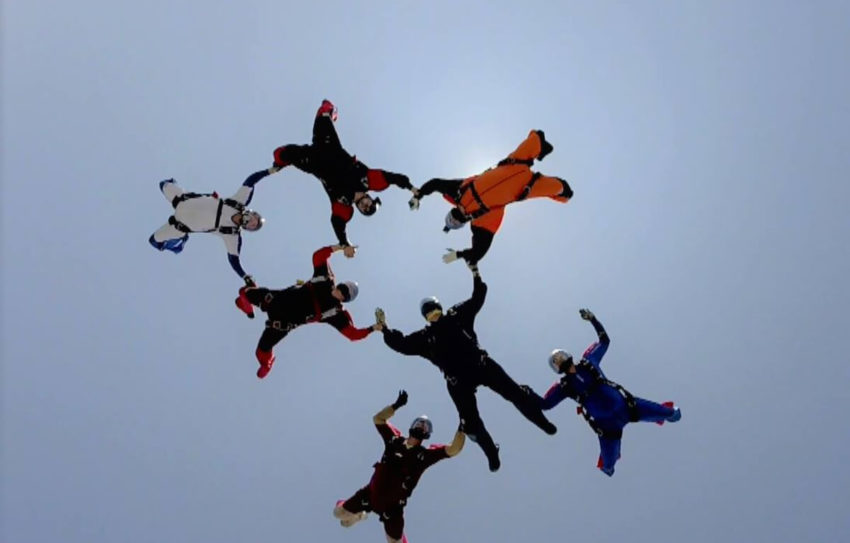
B
Backslide: Backsliding refers to moving further away from an instructor or formation center during freefall. It can be done intentionally as a safety precaution or unintentionally, which is common for students. An aggressive backslide is initiated by pushing the arms forward (straight in front) and bending the knees.
Beer line: An invisible (but very, VERY real) line that marks the area where you shouldn’t be landing. If you cross it, everyone will yell, “BEEEER!” and you will owe a case of the beverage of your choice.
Blue skies: What do you say to someone skydiving? If you want to wish someone good vibes and happy skydives, say “Blue skies!”
BOC: Bottom Of Container refers to the pouch the pilot chute is rolled into. It’s critical to keep an eye on the integrity of the BOC material to lessen the chances of a premature parachute opening (aka a premie)!
BASE: BASE jumping is not the same as skydiving, but we’re throwing it in here as you may hear it discussed around the DZ. What is the BASE jump meaning? Building, Antennae, Span, Earth – and you need skydiving training to be able to jump off of any of these things!
C
Camp: A skydiving course or gathering designed to teach or share and practice specific skills.
Call: “Yo hurry up! We’re on a 10 minute call!” The “call” is how much time is left until wheels up – it lets skydivers know when they should start gearing up, dirt diving their jumps, and get to the loading area. So, what do you say when you jump? When you hear a “NOW CALL!” it’s time to send it!
Circle of Awareness: The COA refers to taking note of everything going on around during the jump. From your altitude to other skydivers, being alert and aware is non-negotiable in creating a safety-oriented environment for everyone.
Crabbing: Okay, now we’re getting into the meat of skydive slang. Think: Flying under the canopy forward and sideways due to the ambient wind. What do skydivers say when they land if they had a wonky landing? Something along the lines of, “DUDE! Did you see me crabbing so hard on my base leg!? Wild.”
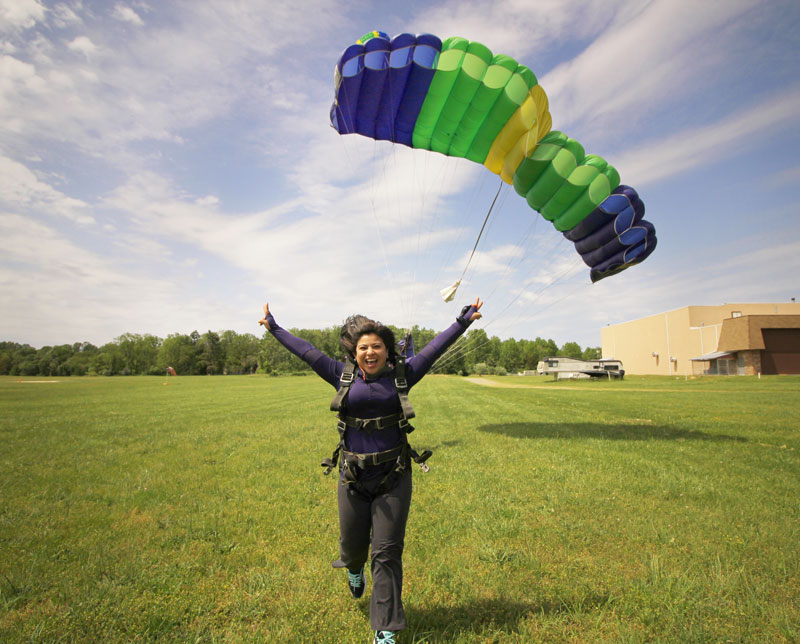
D
Data card: When you get a reserve repack (which happens every 180 days), your rigger will fill out your data card. It includes information about when your reserve was packed, inspected, what type it is, etc. This is secured inside your container and is used as proof that your reserve is good to go.
Decision altitude: This altitude is predetermined and may vary slightly between jumpers; it is when they will decide to cutaway or fly the canopy they have to the ground.
Demo: This skydiving term refers to a demonstration jump or exhibition jump during which professional skydivers will fly into an event in a spectacular way, such as with a flag, game ball, pyrotechnics, etc.
Dirt dive: This is when a group of skydivers, or a student and instructor, plans their freefall on the ground. What do you say in skydiving? “Let’s dirt dive it at the mock up!” (What’s a “mock up” you ask? It’s like a replica of the airplane door and it allows jumpers to practice their exits before doing it for real.)
DZ: Dropzone! The DZO is the dropzone owner, and the DZM is the dropzone manager (Meet our team!).

E
Emergency procedures (EPs): EPs are the lifesaving procedures initiated when a skydiver cuts away their main canopy and deploys their reserve canopy. EPs are done when an un-landable malfunction occurs.
F
Fall rate: This is how fast a skydiver naturally falls. People have different fall rates based on their body position or orientation, clothing (drag), and weight/size. People can adjust their fall rates by adding weight, wearing different types of jumpsuits to increase or decrease drag, and adjusting their body positions.
Formation Skydiving (FS): The FS slang meaning is Formation Skydiving. This is when a group of jumpers creates formations in freefall, usually while belly flying.
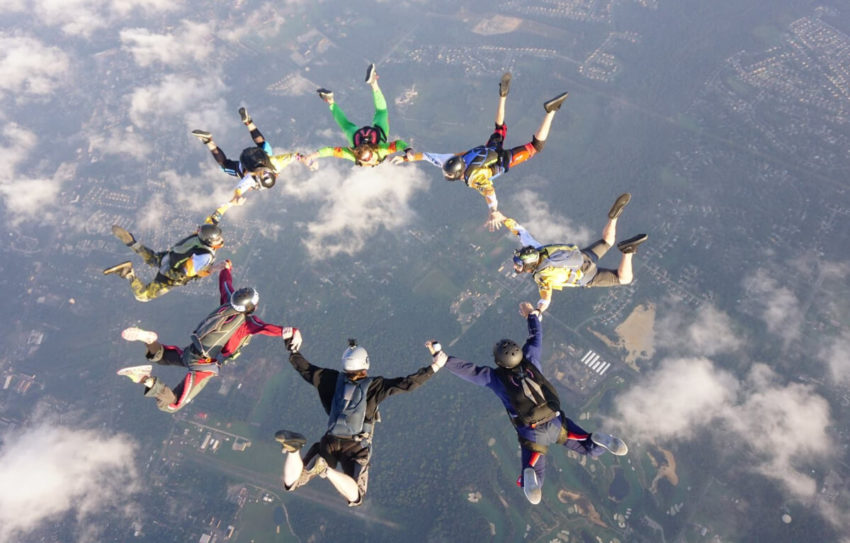
G
Gear check: Performed by the jumper using the gear, or another person. They entail checking that the technology of the rig is sound and that it is put on the jumper properly, setting them up for a successful skydive! Gear checks are done immediately before putting the gear on, before boarding the airplane, and at least once more prior to exit.
Glide ratio: The horizontal distance a canopy travels compared to how fast it is descending.
Grippers: Pieces of tubular fabric sewn onto jumpsuits that make it easier to take grips during FS.
Ground speed: The speed of a plane or jumper over the ground. Ground speed is used to determine the time in between exits from the plane. It’s important to ask what the ground speed is prior to exit to ensure enough separation between each jumper or group.
H
Hacky: The ball (think: hacky sack) that is attached to the pilot chute and used to pull the pilot chute out of the BOC.
Hop n pop: Nearly immediately deploying after exit, you hop (jump out) and pop (deploy the parachute).
Hot fuel (or hot load): When the plane does not shut down in between loads; boarding or fueling the aircraft while it is running. (What is slang for a really good airplane? A hot rod! Check out our beloved airplanes!)
I
IAD: Instructor Assisted Deployment is another, less common, skydiving training program.
J
Jump run: The final stretch the aircraft flies prior to exit; this is when jumpers is the plane will begin to get in position to exit and do THE pre-exit handshake – a simple slap of opposing hands into a fist bump – it’s our special way of saying, “You’ve got this.”
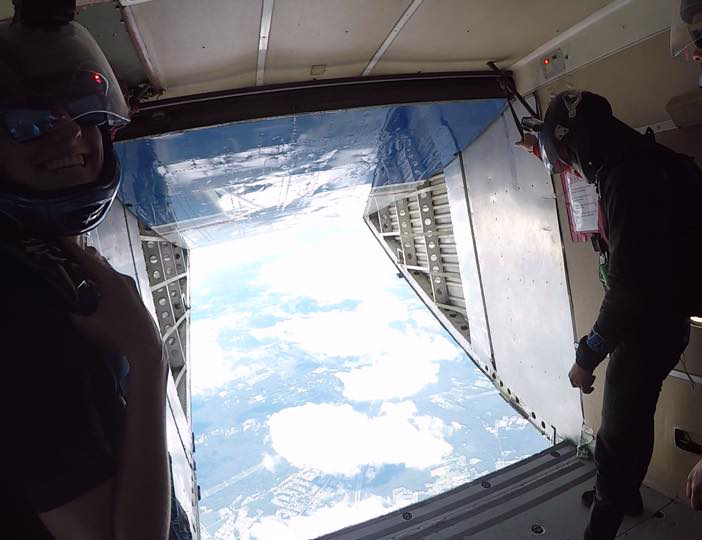
K
Key: During an exit or FS, the jump master will key the other jumpers to exit or do the next predetermined movement. In freefall, this is usually done by eye contact and nodding the head – this is all discussed prior to the jump, during the dirt dive!
L
Landing pattern: The pattern skydivers fly their canopies in prior to landing – flying a predictable pattern can prevent any out of the blue skydive incidents.
Load: In skydiving, people are the cargo or “the load.” Everytime the plane takes off, it carries a load of people who are listed on the flight’s manifest. Each load is numbered so everyone can keep track of the order of takeoff.
M
Main: The primary parachute; commonly called the “main canopy” or just “main.”
Manifest: In skydiving, manifest is a place and also an act. “Manifest” is the name of the office that skydivers go to request to be put on a load, i.e. added to the aircraft manifest (list). When you “manifest,” you put yourself on the list of passengers on the load. “Hey, I’m packed and ready, can you manifest me for load 3?” “Yeah man, I got you!” Walks over to Manifest, to manifest their friend.
N
NOTAM: Notice to Airmen … this serves as an alert to any other aviation entities in the area that skydiving operations are happening. NOTAMs have to be made before takeoff.
O
Organizer: Skydivers call each other by different titles sometimes, usually to reference a rating they hold or position they’re in, such as an organizer. An organizer is someone who is designated to be the leader of a group or camp. A load organizer (LO) invites people to jump together to practice particular skills associated with different skydiving disciplines. Organizers usually have coach or instructor ratings and are adept at working with multiple skill levels.
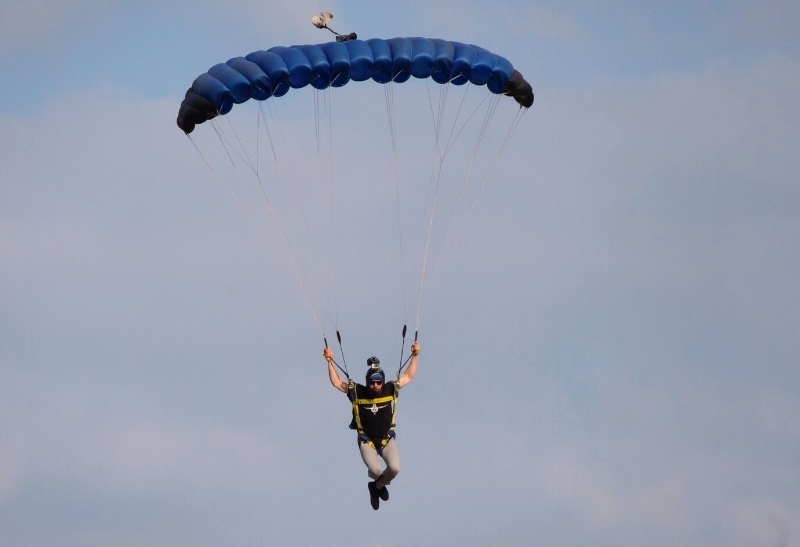
P
Parachuting: An old school term for what a sky jump is called! These days parachuting is a term reserved for military skydiving.
Peas: The “peas” or “pea pit” is a round area marked by pea gravel to be used as target practice for landing.
Pin: The small, comma-shaped piece of metal (which is inserted through the closing loop) that holds the container closed once it’s been packed. You often see skydivers wear them on a necklace. Pin checks are part of gear checks prior to jumping.
Premie: A premature opening of the main canopy (premie) is a type of malfunction and is when the main canopy deploys without the skydiver initiating the deployment. Premies can happen for a few reasons, such as a loose or worn out closing loop – which the pin is inserted through! One way to mitigate the chance of a premature deployment? Regular gear checks!
R
Reserve: The second, back-up, parachute.
RSL: Reserve Static Line. The RSL acts as a tripwire to deploy the reserve once the main is chopped (cut away).
S
Skyhook: A common type of RSL, manufactured by United Parachute Technologies (UPT).
Snivel: When a canopy takes a hot second to open – the longer the snivel, the softer the opening – weee!
S&TA: Safety & Training Advisor. A position held by a highly experienced and rated skydiver. They make sure the BSRs (Basic Safety Rules) required by the USPA are followed, and are the person to speak with if you have safety questions or concerns.
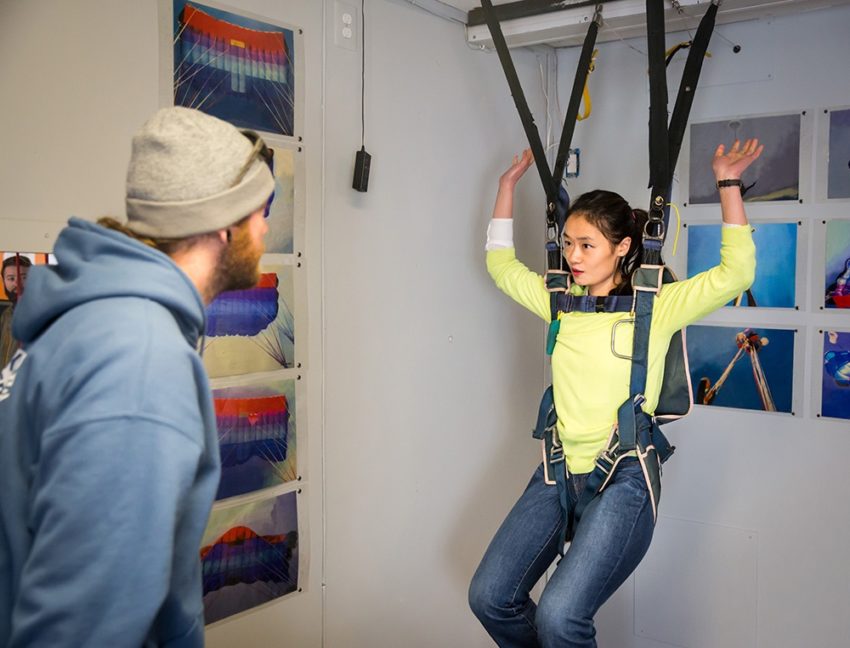
T
Three rings: A configuration of three rings of different sizes that enables the seamless release of both risers when the main canopy is cut away.
Turbulence: Turbulence is choppy air that can be felt in the aircraft or under canopy, also known as a burble. You might think “burble” is turbulence slang but it’s a legit aeronautics term! (It’s also the brand name of popular skydiving manifesting software.)
U
Uppers: The wind strength and direction at a higher altitude – these will affect the exit point from the aircraft in relation to the landing area. They affect skydivers in freefall and those who are doing a high-pull (a hop n pop from a high altitude).
USPA: United States Parachute Association. This is the governing body of skydiving in the US, of which Skydive Cross Keys is proudly a member.
W
Wave off: At the end of the freefall portion of a skydive, jumpers will wave their hands in front of their face to alert others that they are exiting the formation. Similarly, jumpers wave off in the same motion prior to deploying their main – this alerts jumpers around (or above) them that they are about to deploy.
Wheels up: Takeoff time!
Winds aloft: The reading that shows the wind speed and direction at various altitudes (it will show the uppers!). This is typically printed out every morning and posted near manifest.
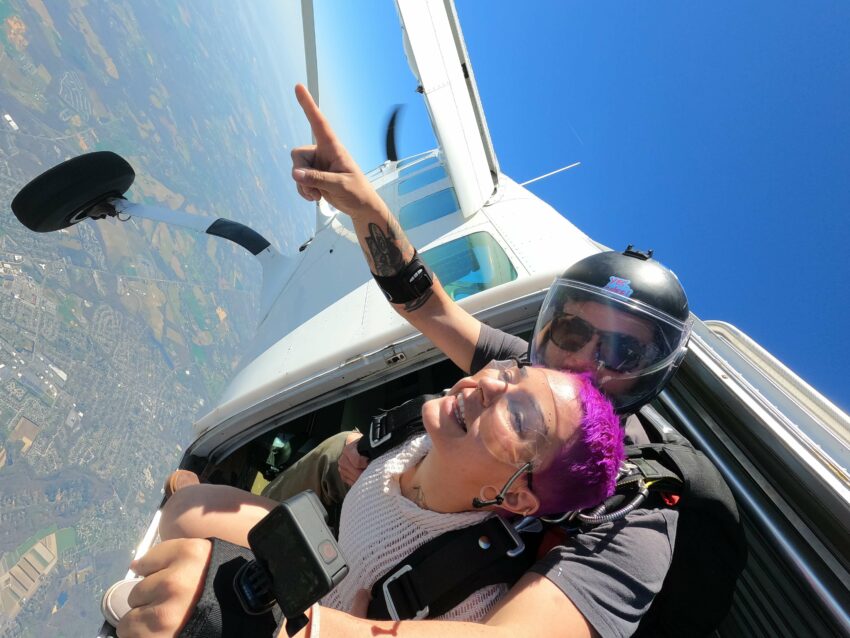
Z
Zoo: A “zoo dive” is when the dive flow is not properly planned out on purpose – or when a dive flow does not go according to plan! Zoo dives are loads of fun and generally involve variously skilled jumpers!
This is a drop in the bucket of skydiving terminology and slang, but a solid start! Put your new skydiving terms to use – come and make a tandem with us, learn how to skydive solo, or join other newly licensed skydivers in our awesome skyfam! Blue skies!